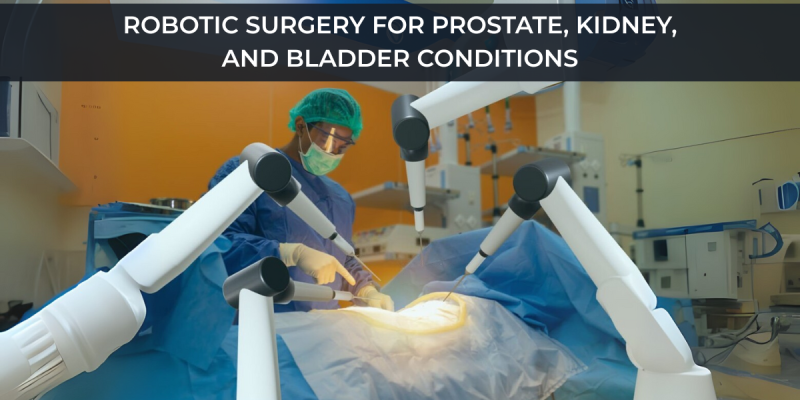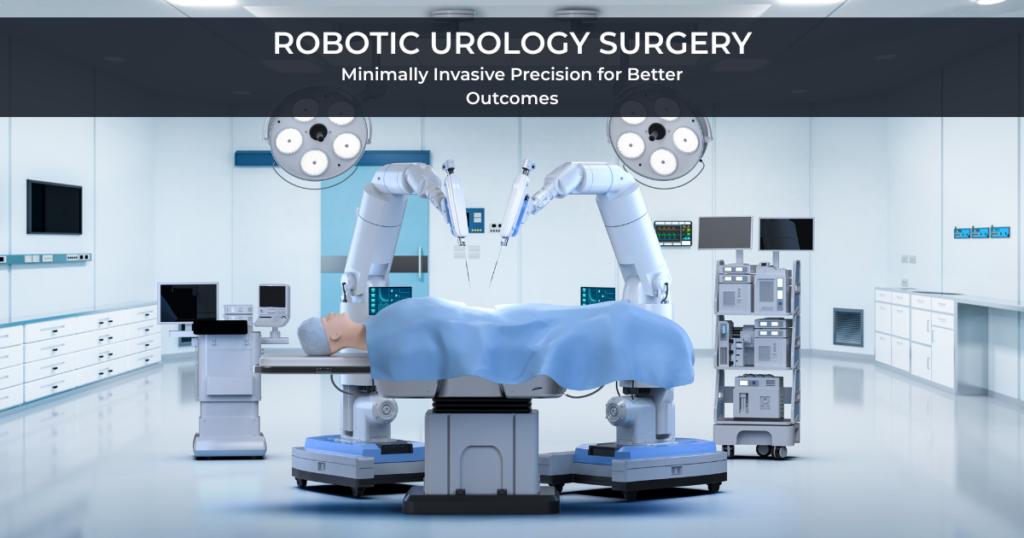Modern medicine is evolving rapidly, and one of the biggest breakthroughs in recent years is robotic urology surgery. Unlike traditional open surgery, robotic surgery is minimally invasive means smaller cuts, less pain, faster healing, and improved precision. For patients dealing with complex urological conditions like prostate cancer, kidney tumors, or bladder cancer, robotic-assisted surgery is now becoming the preferred treatment option worldwide.
In this blog, let us understand what robotic urology surgery is, the common types of robotic procedures, the conditions it treats, and the benefits it brings to patients.
What is Robotic Urology Surgery?

Robotic urology surgery is an advanced surgical technique that uses robotic-assisted technology to perform operations on the urinary tract and male reproductive organs. These include the kidneys, bladder, prostate, ureters, and adrenal glands.
The most widely used system is the da Vinci Surgical System, which allows surgeons to control robotic arms with extreme precision. The surgeon sits at a console and operates tiny instruments that move more steadily than the human hand. This enables highly delicate surgeries in areas that are difficult to reach with traditional methods.
Unlike open surgery, which requires large incisions, robotic-assisted surgery is performed through small keyhole cuts. This leads to less bleeding, reduced hospital stay, minimal scarring, and quicker recovery.
Most Common Robotic Urology Procedures
Robotic technology can be applied to many urological surgeries. Here are the most common robotic urology procedures performed today:
1. Robotic Surgery for Prostate Cancer Treatment
- Prostate cancer is one of the most common cancers in men.
- The robotic procedure, called robotic prostatectomy, involves removing the prostate gland with high precision while protecting nearby nerves and tissues.
- This helps reduce complications like incontinence or erectile dysfunction compared to open surgery.
2. Robotic Surgery for Kidney Removal
- Also known as robotic nephrectomy, this procedure is done when a kidney has to be removed due to cancer, severe damage, or non-functioning kidney.
- Robotic assistance allows surgeons to remove the kidney safely through small cuts, ensuring minimal blood loss and faster patient recovery.
3. Robotic Surgery for Bladder Cancer
- In cases of bladder cancer, a robotic cystectomy may be performed to remove part or all of the bladder.
- The robotic system provides accuracy in delicate reconstructions, such as creating a new pathway for urine.
4. Other Types of Robotic Surgery in Urology
- Partial nephrectomy: Removing only the cancerous part of the kidney while preserving the rest.
- Pyeloplasty: Repairing blockages in the kidney’s drainage system.
- Adrenal surgery: Removing tumors from the adrenal gland.
Robotic Surgery for Prostate, Kidney, and Bladder Conditions

Robotic-assisted technology is especially beneficial in treating three major urological conditions: prostate cancer, kidney tumors, and bladder cancer.
Robotic Surgery for Prostate Cancer Treatment
- The most common robotic procedure in urology is radical prostatectomy for prostate cancer.
- Surgeons can carefully remove the prostate gland while sparing the surrounding nerves that control urinary and sexual functions.
- Patients often experience less blood loss, reduced hospital stay, and quicker return to normal life compared to open surgery.
Robotic Surgery for Kidney Removal
- For patients with kidney cancer or non-functional kidneys, robotic nephrectomy is highly effective.
- It allows removal of the kidney (total nephrectomy) or only the diseased portion (partial nephrectomy).
- The robotic approach offers better vision and precise tumor removal without damaging nearby healthy tissue.
Robotic Surgery for Bladder Cancer
- In advanced bladder cancer, robotic cystectomy (bladder removal) may be required.
- Reconstructive techniques, such as creating a new bladder from the intestine (neobladder), are easier and more precise with robotic tools.
- Patients often report better recovery outcomes and reduced complications compared to traditional open methods.
Benefits of Robotic Surgery in Urology

One of the biggest reasons for the growing popularity of robotic procedures is the wide range of benefits they offer. The benefits of robotic surgery in urology include:
1. Minimally Invasive Approach
- Small incisions instead of large cuts.
- Less pain, minimal scarring, and lower infection risk.
2. High Surgical Precision
- Robotic arms eliminate natural hand tremors.
- Better control in tight spaces like the pelvis or near delicate nerves.
3. Less Blood Loss and Fewer Complications
- Smaller cuts and precise dissection reduce bleeding.
- Lower risk of complications during and after surgery.
4. Faster Recovery After Robotic Urology Surgery
- Most patients can go home sooner, sometimes within a couple of days.
- Quicker return to work and daily activities.
5. Better Functional Outcomes
- Especially in prostate surgery, robotic methods help preserve urinary control and sexual function better than open techniques.
6. Shorter Hospital Stay
- Patients often recover faster and require fewer days in the hospital.
Recovery and Outcomes After Robotic Urology Surgery
Every patient’s recovery timeline may vary, but in general, faster recovery after robotic urology surgery is one of the biggest advantages.
- Hospital stay: Most patients are discharged within 1–3 days after surgery.
- Pain and discomfort: Reduced compared to open surgery due to smaller cuts.
- Return to daily life: Patients can usually resume light activities within 2–3 weeks and normal routine within 4–6 weeks.
- Long-term results: Robotic surgery offers excellent cancer control and functional outcomes in cases of prostate, kidney, and bladder surgeries.
Doctors typically recommend follow-up visits, lifestyle modifications, and regular checkups to ensure smooth recovery and long-term health.
As a Urologist at Yashoda Hospital, somajiguda, I have seen how robotic technology has transformed the way we treat complex urological conditions of the prostate, kidney, and bladder. My priority is to ensure that every patient receives personalized, advanced, and compassionate care so that they achieve the best possible recovery and long-term results.
If you are searching for the best urologist in Hyderabad and want to explore minimally invasive options like robotic surgery, I invite you to consult me. Together, we can discuss whether robotic urology surgery is the right solution for your condition and design a personalized treatment plan for faster recovery and better quality of life.
Final Thoughts
Robotic technology has truly transformed the field of urology. From robotic surgery for prostate cancer treatment to robotic surgery for kidney removal and robotic surgery for bladder cancer, patients are now able to receive safer, less invasive, and more precise care.
The benefits of robotic surgery: smaller scars, less pain, faster recovery, and better outcomes make it a preferred option for both patients and surgeons.
If you or your loved one has been diagnosed with a urological condition, consult a urologist who specializes in robotic-assisted procedures. With the right care, you can expect excellent outcomes and a quicker return to a healthy life.

